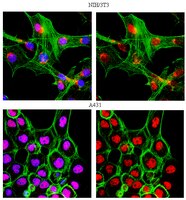ABE52 Sigma-AldrichAnti-Cyclin D Antibody
Use Anti-Cyclin D Antibody (Rabbit Polyclonal Antibody) validated in WB, ICC, IP to detect Cyclin D also known as B-cell CLL/lymphoma 1, BCL-1 oncogene.
More>> Use Anti-Cyclin D Antibody (Rabbit Polyclonal Antibody) validated in WB, ICC, IP to detect Cyclin D also known as B-cell CLL/lymphoma 1, BCL-1 oncogene. Less<<Prodotti consigliati
Panoramica
| Replacement Information |
|---|
Tabella delle specifiche principali
| Species Reactivity | Key Applications | Host | Format | Antibody Type |
|---|---|---|---|---|
| H, M, Pm | WB, ICC, IP | Rb | Affinity Purified | Polyclonal Antibody |
| References |
|---|
| Product Information | |
|---|---|
| Format | Affinity Purified |
| Control |
|
| Presentation | Purified rabbit polyclonal in buffer containing 0.1 M Tris-Glycine (pH 7.4, 150 mM NaCl) with 0.05% sodium azide. |
| Quality Level | MQ100 |
| Physicochemical Information |
|---|
| Dimensions |
|---|
| Materials Information |
|---|
| Toxicological Information |
|---|
| Safety Information according to GHS |
|---|
| Safety Information |
|---|
| Storage and Shipping Information | |
|---|---|
| Storage Conditions | Stable for 1 year at 2-8°C from date of receipt. |
| Packaging Information | |
|---|---|
| Material Size | 100 µg |
| Transport Information |
|---|
| Supplemental Information |
|---|
| Specifications |
|---|
| Global Trade Item Number | |
|---|---|
| Numero di catalogo | GTIN |
| ABE52 | 04053252512896 |
Documentation
Anti-Cyclin D Antibody MSDS
| Titolo |
|---|
Anti-Cyclin D Antibody Certificati d'Analisi
| Titolo | Numero di lotto |
|---|---|
| Anti-Cyclin D - 2202495 | 2202495 |
| Anti-Cyclin D - 2266742 | 2266742 |
| Anti-Cyclin D - 2492779 | 2492779 |
| Anti-Cyclin D - 2782076 | 2782076 |
| Anti-Cyclin D - 2986033 | 2986033 |
| Anti-Cyclin D - 3219899 | 3219899 |
| Anti-Cyclin D - 3719623 | 3719623 |
| Anti-Cyclin D - 3744897 | 3744897 |
| Anti-Cyclin D - 3990340 | 3990340 |
| Anti-Cyclin D - 4187281 | 4187281 |














